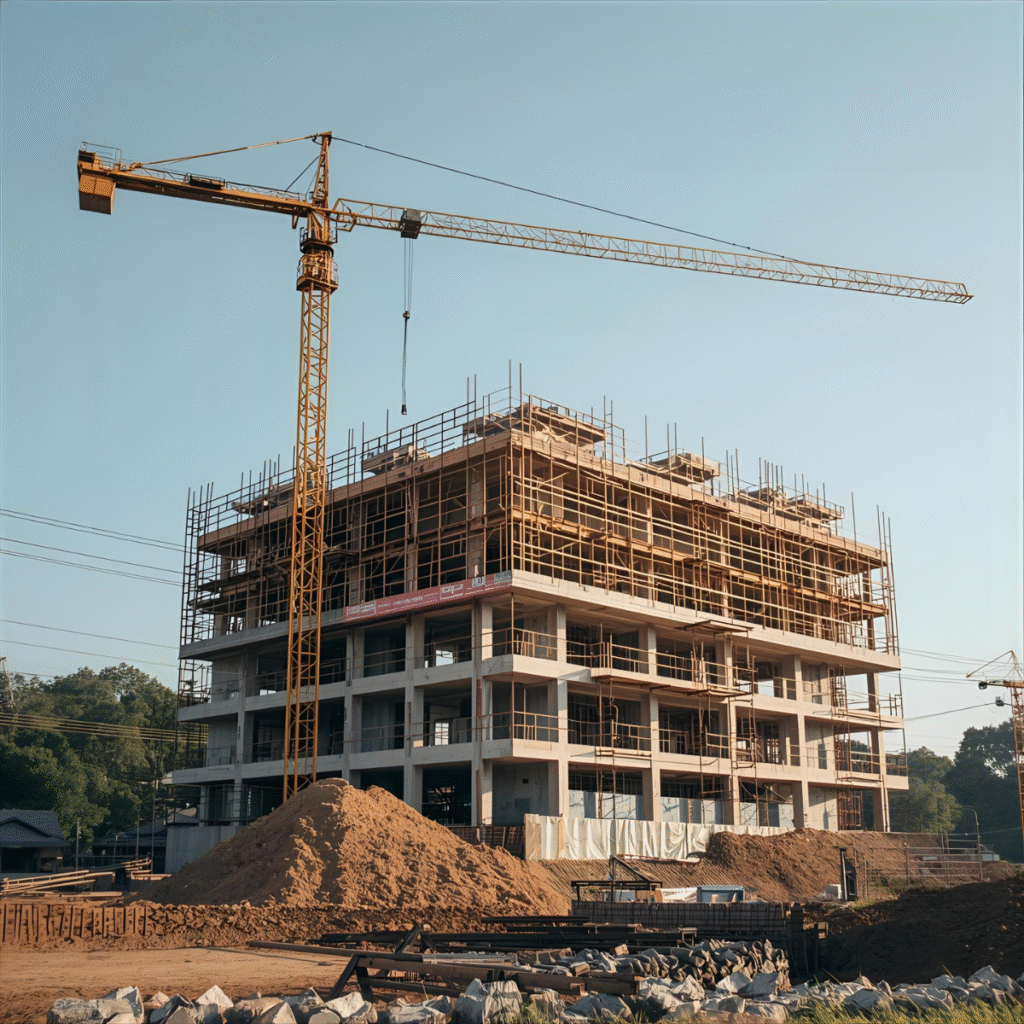When you plan to build a house or any type of building, one of the most important decisions is choosing the right structural system. Two of the most common methods are load-bearing walls and column-beam structures. Both approaches have their own benefits, limitations, and best-use scenarios. If you are planning a new home, an office, or even a commercial project, understanding these systems can help you make the right choice.
In simple terms, load-bearing walls are walls that directly carry the weight of the building, while in a column-beam structure, the load is carried by vertical columns and horizontal beams, and the walls mainly act as partitions.
Let’s explore both systems in detail with examples, pros and cons, and how to decide which one is better for your project.
What is a Load-Bearing Wall?
A load-bearing wall is a wall that supports the weight of the roof, slab, and the structure above it. Instead of transferring the weight to separate columns, the wall itself carries the load and transfers it directly to the foundation.
Think of it as the backbone of a small house. The walls are not just partitions; they are the main strength of the building.
Example:
In traditional village houses or old-style buildings, thick brick walls are used. These walls carry the load of the roof and upper floors. The thickness of the walls increases as the number of floors increases.
Advantages of Load-Bearing Walls
- Cost-Effective for Small Houses: Since you don’t need separate columns and beams, the cost of steel and concrete reduces.
- Good Thermal Insulation: Thick brick walls provide natural insulation against heat and cold.
- Strong and Durable: Load-bearing walls made with quality bricks or stones can last for decades.
Simple Construction: Builders with basic skills can construct load-bearing houses without advanced machinery.
Disadvantages of Load-Bearing Walls
- Limited Floors: Not suitable for high-rise buildings. Typically supports up to 2–3 floors only.
- Less Flexibility: Once built, you cannot easily remove or change walls because they carry the load.
- More Wall Thickness: Thick walls take up more space inside the house, reducing carpet area.
Slower Construction for Large Projects: Requires more material and time if the building is big.

Best Use of Load-Bearing Walls
- Ideal for small houses, farmhouses, or independent villas.
- Works well in low-rise residential buildings up to 2–3 stories.
- Suitable where land cost is low, and space consumption by thick walls is not a big issue.
What is a Column-Beam Structure?
A column-beam structure is a modern construction system where vertical columns (made of reinforced concrete) and horizontal beams form the skeleton of the building. The load of the roof and slabs is transferred to columns, and finally, to the foundation.
In this case, the walls do not carry the load. They are only used for partitions, design, or enclosing the space.
Example:
Most modern apartments, offices, shopping malls, and skyscrapers use column-beam structures. You might notice thinner partition walls inside such buildings, which can even be changed or removed without affecting the structure.

Advantages of Column-Beam Structure
- Flexibility in Design: You can easily plan open spaces, bigger rooms, or even change the wall layout in the future.
- Supports Multi-Storey Construction: Can be used for buildings ranging from 2 floors to 100+ floors.
- Faster Construction: With modern machinery and RCC work, large projects can be completed quickly.
- Thinner Walls: Saves space and gives more carpet area inside.
- Strong Earthquake Resistance: RCC columns and beams provide better structural stability.
Disadvantages of Column-Beam Structure
- Higher Cost: Requires more cement, steel, and skilled labor, which increases cost compared to load-bearing walls.
- Professional Expertise Needed: You need trained engineers and contractors for accurate design and execution.
- Less Thermal Comfort: Thin walls made of bricks or blocks may not provide as much insulation as thick load-bearing walls.
Best Use of Column-Beam Structure
- Ideal for apartment complexes, offices, shopping malls, and commercial projects.
- Works best in urban areas where land is costly and maximizing space is important.
- Recommended for earthquake-prone zones, where RCC structures provide better safety.
Key Differences Between Load-Bearing Wall and Column-Beam Structure
Factor | Load-Bearing Wall | Column-Beam Structure |
Load Transfer | Walls carry load to foundation | Columns and beams carry load |
Floors Supported | Up to 2–3 floors | Multiple floors (skyscrapers possible) |
Wall Thickness | Thick walls required | Thin walls (non-load bearing) |
Flexibility in Design | Limited | Highly flexible |
Construction Cost | Lower for small houses | Higher but efficient for large projects |
Construction Speed | Slower for big projects | Faster with modern techniques |
Best Suited For | Small houses, villas, low-rise buildings | Apartments, malls, offices, high-rises |
Real-Life Example
Imagine you are building a 2-floor independent house in Lucknow. A load-bearing wall system might save you construction costs and provide natural insulation.
But if you are planning a 10-storey apartment complex, then a column-beam structure is the only practical option, as it can handle more load and offers flexibility for multiple apartments.

Factors to Consider Before Choosing
- Type of Project – Small house vs. multi-storey apartment.
- Budget – Load-bearing walls are cheaper, but column-beam structures save costs in large projects.
- Land Value – In cities like Lucknow, where land is expensive, column-beam structures maximize carpet area.
- Future Flexibility – If you want the option to modify walls later, column-beam is better.
- Safety – In earthquake-prone zones, RCC column-beam structures are safer.
Which One Should You Choose?
- If you’re building a small, low-rise house in a suburban or rural area, a load-bearing wall system is cost-effective and durable.
- If you’re building a multi-storey apartment, commercial building, or office, go with a column-beam structure for better flexibility, safety, and space efficiency.
Conclusion
Both load-bearing walls and column-beam structures have their importance in modern construction. The choice depends on your project type, budget, land cost, and long-term needs. For small, traditional homes, load-bearing walls still work wonderfully. But for large-scale urban projects, column-beam structures are the backbone of modern cities.
By understanding these systems clearly, you can discuss better with your architect or construction company and make the right choice for your dream project.
FAQs
Can a load-bearing wall be removed?
No, load-bearing walls carry the building’s weight. Removing them without support can cause structural failure.
Which is cheaper – load-bearing or column-beam?
For small houses, load-bearing walls are cheaper. For multi-storey buildings, column-beam structures are more economical in the long run.
How many floors can a load-bearing wall support?
Usually up to 2–3 floors, depending on wall thickness and materials.
Why are column-beam structures preferred in cities?
Because they save space, support more floors, and offer design flexibility.
Which is safer in earthquakes – load-bearing walls or column-beam structures?
Column-beam structures with RCC are safer in earthquake-prone regions.
